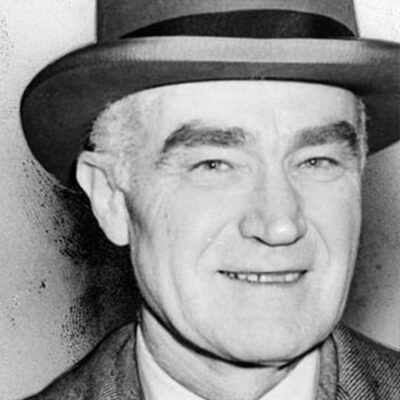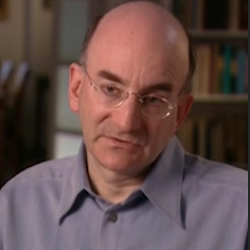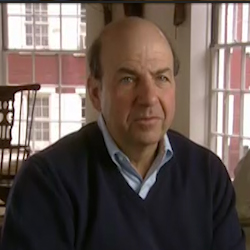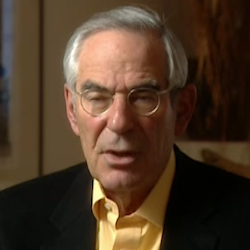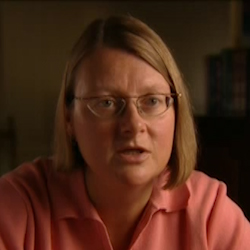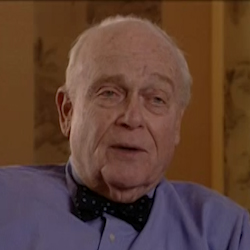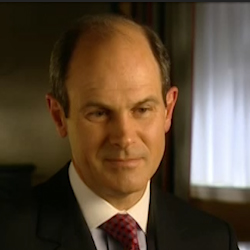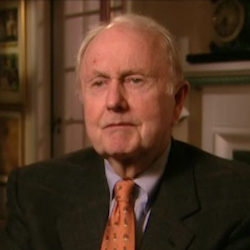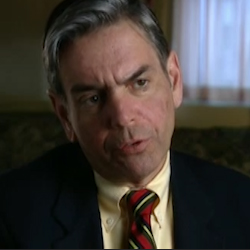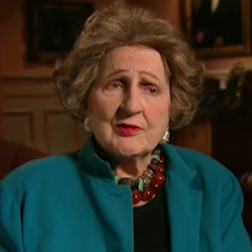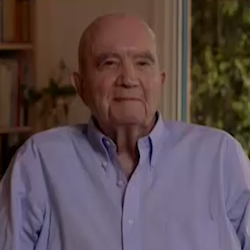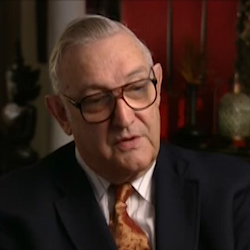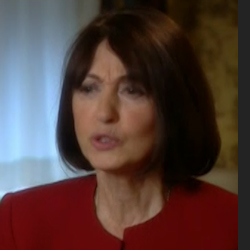Speaker We just started. OK, great. Today is Wednesday, March 26. We are interviewing Wendy Kozel for Henry Luce in the making of the American Century.
Speaker I think, you know, I’m going to start off first with more general questions, and then the main one is it’s kind of two fold, but it’s the same question. What do you think are the most important things? This film could convey about Henry Luce, and I’m thinking about it, particularly because, to my surprise, people who aren’t my contemporaries who are younger than I am to know who I’m sure most of your students don’t know.
Speaker Yeah.
Speaker So what would be important to convey about about him and his.
Speaker I see. His his strengths are in point together. This publishing empire that helped to consolidate national culture. I think one of the visions that he had early on and he kept throughout all of the different magazine projects that he did, was this desire to create news publications that showed national and international events and happenings, and that really moved the media away from the local and provincial into a much more national and internationalist perspective. And I think the other really important thing that he does is. Recognized very early on and recognized better than a lot of other people who are also working on this, but recognize the importance of the visual culture and that Americans are really excited about visual culture. And it takes that excitement and turns it into these products that people want to look at and consume. Week after week. And so is it important is in many ways helping to establish a visual of visual language of the news. And much of the way in which the news is reported today, both in newspapers, but especially in television, I think can be the antecedence or in time in life.
Speaker And to a lesser extent, fortune. What do you think?
Speaker Culturally, politically. His influence was during his time. His influence on the country. How how great an influence we have. How did he exercise that influence?
Speaker Well, I see the influence in two different ways. The first is that. Magazines were so part popular and that bring product kind of power, prestige with that, that people wanted politicians, people in Hollywood, cultural and political figures wanted to be depicted in life and time. And because of the popularity of the magazines that gave Henry Luce himself access to all these political and cultural figures. But it also gave reporters and photographers access that a lot of other news magazines and newspapers didn’t necessarily have. So I think the influence was in that regard. There’s tremendous access to people. And you see and for instance, in life magazines, articles being published by Winston Churchill, I mean, you got the Churchill essay and things like that. So that was one kind of influence. The other is in the magazines themselves. They were so widely read and so popular that, you know, that you have to credit looses influence through the magazines themselves and whatever kind of white power they had to shape Americans understandings of themselves and the world around them actually comes to the magazines.
Speaker Did you when you were younger, did you get life? Did you read life?
Speaker Oh, yeah. Yeah. I think my family got both time and life. But I remember I remember vividly looking through the issues of Life magazine. I certainly remember the famous issues from the Vietnam War and looking poring over the images. And then you’ll remember ever reading any of the text.
Speaker But looking at pictures and finding them so powerful and so compelling.
Speaker And then Time magazine, I remember it like everybody else, reading it from back to front. You know, you always start with the gossip and then the movies and then eventually get you know, we don’t get to the important articles.
Speaker People, it seemed like, particularly people who were more liberal, seemed to have like this love, hate relationship with Time magazine. What was that about?
Speaker Well, I think.
Speaker What Lewis and his co publisher, Britton Hayden, tried to do or did do with with Time magazine was to present a digest, an accessible digest of these complex events and or issues or concerns that were happening in the period and translated them into this accessible digest with a point of view. And I think the way in which it. Always simplify these complex issues frustrates especially a lot of intellectuals, because you know that the very thing that makes it so appealing, it’s accessible. You can read the whole magazine in an hour and you feel like you’ve, you know, learned something about what’s going on the world. But you’ve reduced these very complex issues to very simple explanations and explanations with the point of view. So I think that that was something people were frustrated with at the same time. Because it was such a enormously powerful empire and Lewis was willing to spend the money. They heard great photographers and great reporters. And so there was always really interesting things to find in these magazines. They’re never just awful or just wonderful. I mean, there is sort of this complex. Products that people find something that they’re interested in.
Speaker What about you mentioned sort of had this point of view? Can you talk about.
Speaker Sort of how that was indeed sort of intrinsic to the magazines, especially time. You know, that this was not, quote unquote, objective news reporting.
Speaker Right. And I think. Lewis gets a lot of criticism for it, especially early on that this is this is reporting with a point of view or actually digesting other people’s reporting with a point of view and the mag. All of the magazines always had a very strong editorial focus, even if they didn’t have an edit editorial page persay. And then when we talk about the time inks influence, even, you know, up through today, we see that kind of directed strongly editorial. You know, focus of reporting coming out of out of the time, what they call time, speak or life speak, this kind of particular kind of language that they would use to represent. Stories to tell the story, they would, you know, use metaphors and descriptions that would. You know, shape or inflect the story with a particular slant, you know, either positive or negative. And and you see that today in the way in which even, you know, the grand. Newspaper of presumably objective reporting. New York Times does, you know, does the same kind of reporting.
Speaker What was what was?
Speaker What was new and different about Time magazine?
Speaker I think first and foremost, that it was its focus was national and international.
Speaker Let me interrupt for just one second. One thing that I didn’t say that I showed is people are hearing my question. So you have to reach. OK. What we’re talking about in Turkey in your ears. OK. So, again, the question being, you know, what was new and different about Time magazine?
Speaker What was new about time that distinguished it from other newspapers and magazines of the period? Was it focused on national and international events and cultural developments? And what they did was they took it especially the beginning before they could afford to have reporters and send them off to places around the world as they would take other people’s newspaper accounts, other newspaper accounts, and we write them in in their particular time speak with their kind of odd characterizations and grammatical changes that made it catchy and interesting. And so they would present this sort of digest of what happened, but they would focus on national and international events. And most of the kinds of news reporting that you got prior to that was much more focused on local or regional events that especially in newspapers. So they they became this. One of the places that middle class people could turn, because they’re really the only ones who could afford to buy the magazine, especially in the 1920s and early 30s, but place for them to turn to find out about what was happening under national and international level.
Speaker You mentioned earlier, and I just want to go back about this formation of a national culture time and then later life kind of played into.
Speaker Starting in the late 19th century, you start seeing the development of. Both. Commercial. Our commercial culture that evolves. I mean, it takes a really takes, you know, 30, 40 years to develop. But you start seeing first in magazines, but also then with the introduction of radio in the 20s and then obviously much later with well, then with film and then later with television. The consolidation of different kinds of cultural practices that develop into what we can now call a national culture. If early on magazines were appealing to people in particular regions of the country or even just, you know, in a particular newspapers were appealing to the readers in a particular city. What magazines are doing is trying to reach a national audience. And part of this is helped by the development of national and national level. Industries that want to advertise in these magazines. And you start first thing in Ladies Home Journal. That becomes one of the key places where you see advertisers trying to appeal across the nation to readers. And as I said, this is a slow process that develops and it really gets becomes very important in the 1930s for a couple of reasons. One of the most important is that this is a period of social unrest and crisis around the depression and. This, coupled with an increasingly literate audiences, more and more people are turning to the media for information. And then finally, some of the technol technological developments that happen with both film and camera technologies help to develop this national culture. And you see it developing in radio. You see it developing in film with the power of Hollywood to create films that are appealing to audiences across the country. More Americans are flocking to the movies than you ever saw before. And then the magazines which develop national audiences and begin to speak to create, not just reflect, but to create this national culture. And there’s as these cultural forms become more and more successful, you start seeing very similar kinds of images in a variety of different media, which further helps consolidate this national culture.
Speaker We talk about actually when we talk about formation of life. Can you talk a little bit about I think we talked about this before, the evolution of. Looses development of photo. Photo journalism from time to Fortunata life.
Speaker How he could have evolved in that direction.
Speaker Life’s development. I mean, sorry, Luce’s development of photo journalism happens over. Over. Probably about a 10 year period. He starts first encouraging editors in Time magazine, these photographs and.
Speaker There, for the most part, headshots. And then actually in the early 1930s during during Franklin Roosevelt’s first term, there is a very important series of photographs that appear on TIME magazine of the president, which shows him not in a very formal portrait pose, but rather the informal put pictures of. The president laughing, smoking a cigarette, being casual, and historians point to that photo essay over those photographs is really not a photo essay yet, but those photographs as indicative of growing interest in photographs and what photographs can convey to an audience how they can capture audiences interest and enthusiasm. One of the really interesting things about the kind of informal photographs of. Of figures like President Roosevelt was there. They created an intimacy between the viewer and in the subject of the photograph. You know, rather than a formal distancing image, you know, you see the president being casual and then people presumably can relate to that. So obviously, early on, let loose, start experimenting with photographs in TIME magazine and then develops Fortune magazine, which was of a magazine devoted to businessmen. It’s a very expensive magazine for the high powered corporate leaders. It’s produced on very expensive. Paper. It’s a big, thick magazine with long stories about corporate leaders. But what you see there is, first of all, loose hiring famous photographers to take pictures for the magazine. But also his willingness to spend money to have big photo spreads associated with within story. And the other interesting thing is then you start seeing him using photographs or the magazine using photographs to help tell the story. And so these are key precursors to Life magazine. Now, there were a number of different. People experimenting with photo magazines and there is also some very important magazines being published in both Britain and in Germany using the photographs and photos in creating photo magazines that were also influences on Life magazine. But I think clueing life, time and fortune were important precursors. And. And. So he’s experimenting through the in the early 1930s with this with photographs, and then by 33, 34, they stare earnestly looking, developing plans for the new magazine.
Speaker It occurred, you know, life.
Speaker Life begins in a particular time in this particular time. There’s the FSA photography, the therms and that sort of thing. Can you talk a little bit about the context in which sort of life came to me?
Speaker Life life’s photographs, especially their news photographs, have a credibility that’s dependent on the belief that photographs are going to tell you about real events, that they’re going to be truthful account of what really happened. And that trust in the visual documentation. Develops out of ruly photographic projects and most particularly social reform photography. And the key event as a key project that influences Life magazine in the 1930s is the Farm Security Administration’s photographic project.
Speaker Farm Security Administration was part of Franklin Delano Roosevelt’s new one of his New Deal agencies. And this was an agency designed to deal with the tremendous farm crisis on American farms related to the the Dust Bowl and the floods and the basically the farm disaster that was putting.
Speaker Farmers into this economic crisis in a devastating. Personal and financial crises.
Speaker What the agency did to document not only what the crisis was, but how the government was attempting to cope with these problems, it hired all these photographers and sent them out with cameras to photograph it. The conditions of these incredibly impoverished people. And these photographs have become among the most famous photographs of the 1930s. And if you know anybody, remember you recognizes any photographs from the 30s. That’s from the Farm Security Administration. Perhaps the most famous, of course, is Dorothea Lange’s migrant mother, which is the photograph of the it’s a close up photograph of a woman holding a baby with two of her children leaning on her child, her shoulders faced away from her. And it’s an incredibly powerful photograph of both the suffering of the of this this agricultural poor, but also an image of nobility and devotion to family. And I think that’s what the Farm Stroner Administration photographs did so beautifully was rather than showing photographs of the poor is Spratt or, you know, it’s their fault or, you know, somehow that they’re you know, they deserved to be poor. These photographs showed them as as victims of these, you know, natural disasters. And the other thing, of course, that that firm screening ministration did was show photographs of what the government did to solve these problems. So they were great public relations. So anyway, so these are very important projects that Life magazine is well aware of. And in the early years of Life magazine, they published a number of the Farm Security Administration photographs, which gives them credibility. But the Farm Secured Administration, of course, is very happy to have their photographs published in places like Life and other magazines and newspapers, because that’s how that they can distribute them and get publicity for it. So it’s a mutually influential. But I think one of the key a couple key things that the Farm Security Administration offered or help to influence life in photographs was the credibility of photographs, ability to document a problem or a crisis, but also visual strategies or visual language for documenting that crisis and bringing the camera in close to showing in an intimate way the suffering, but also then the ability of the poor is something that you can also see in the early life photographs and also the emphasis on what we often turn from term straight photography or document photography, where you don’t manipulate the image that you don’t in any way crop it or manipulated or fabricated so that they’re trustworthy photographs and in life always stuck to that kind of formula of.
Speaker Creating representing photographs that at least the promise to reduce were not manipulated. Now, whether they are not is something we can talk about. But at least that was the promise of the magazine that these are these are straight talking documents of reality. They’re not manipulated.
Speaker Well, as long as we’re he needs.
Speaker As long as you brought it up.
Speaker Since we’re here to talk about the let’s talk about whether or not they fulfilled, fulfilled that promise, whether or whether, in fact they did.
Speaker Manipulate.
Speaker Photography in a way to to to evoke a certain reaction.
Speaker The photographs that are published in Life magazine, I don’t think wherever manipulated in terms of dark darkroom documentations or putting in people who weren’t actually in the photograph to begin with or any kind of that kind of level of highly interventionist manipulation.
Speaker But there’s another way in which you can see them as being manipulative in that life. Love to show photographs of people being spontaneous, ignoring the camera, having conversations in which you just sort of seems like the photographer just happened to walk in and, you know, catches people unawares. But, of course, these are shoots. And oftentimes there’s one picture I can remember of a picture of a woman who became mayor of this small town in Virginia. And she there’s a picture of her getting ready for her inauguration and she’s talking to her daughter and she’s at her makeup table and the daughter sitting on the bed and she’s posing like this for her daughter. And it’s, you know, of course, supposed to be this spontaneous image of the daughter of the mother posing for the daughter. But in fact, you know, there would have been lights and camera, people and reporters all in this small little bedroom. And there’s something spontaneous about it.
Speaker So I think there’s that level of manipulation going on that it tried to create an illusion of of ordinary life that. That was manipulated.
Speaker Right. So.
Speaker What was new and different about life and why was it such a instant sensation?
Speaker What was new about life was more than anything. Course, the pictures were there wasn’t a picture magazine before life and why it sustained them became as popular and powerful as it is compared to other picture magazines. That’s what’s interesting about what’s new and different about it, because as soon as it came out here, a whole host of other picture magazines that developed within the next year look being the most well known and lasting the longest of them. But what life did that the others didn’t was. And this goes back to Henry Luce, his willingness to pay for the top photographers and top reporters in their fields at the time. And not only was he willing to pay their salaries. He was willing to send them around the world on these lavish expense accounts to.
Speaker To get the story wherever it was, so life got more stories and better stories than anybody else.
Speaker The other thing that is really important to understand about why life was so important was the production of the magazine itself. It was slightly bigger than the other magazines that were popular at the time, like Saturday Evening Post. And so it had these wonderful large formats with these great pictures. It used heavy coded stock, which meant that the the the ink. From that, the inputs sit on top of that paper rather than being absorbed. Which means that you get much better detail out of your photographs. So if you compare life and look, although look as interesting pictures, they don’t reproduce as well as they do. And Life magazine. And then finally, I think one of the most important innovations that life offers is the photo essay itself. You have before that all sorts of experimentation with the use of photographs and layouts. The newspapers are using. Photographs more and more through the 20s and early 30s, but they tend to be individual photographs or maybe a couple of photographs on a particular topic. But what life does is help to develop the photo essay, which is telling a story through photographs and captions and text. And you find that typically what a photo essay in life will do will be start with either a half page or a full page photograph. That will be the setting the stage for the story. And then through a series of smaller and larger photographs which create a sense of rhythm and variety, and then it will tell the story and pictures. Although the captions and texts are very important in helping to direct the message of the story. And so it’s the interest interaction between the photographs and this, the text together they create this photo essay. But it’s a coherent narrative of the photo essay that I think is really important innovation that that life accomplishes. And what that teaches newsmedia is how to use photographs to tell a story. And one of the huge influences then is that what end up developing is that the newsworthy events or those that can be told with pictures and you see that today in television, which. You know, if it’s not newsworthy, if there’s not a camera there, it’s looks like much less likely to be covered by the news media.
Speaker I ask you to try to focus your. Your eyeline a little bit more turn. I mean, it’s fine if you have to kind of search, but to try to stay focused.
Speaker Let’s talk about that. Let’s talk about that first. Sure. We had.
Speaker I mean, just maybe somebody put the alcohol.
Speaker We talked about this before and I didn’t get a good answer from anybody else. You seem to have some thoughts about why do you think they chose that would be to inaugurate their very first.
Speaker This is such a great image. This is a photograph in the for the cover photograph of the 1936 issue of Life magazine. This first issue is by Margaret White. And it’s a photograph of. Fort Peck, which was a dam that they were building in Montana as part of one of the New Deal projects. Why did why did they pick this photograph? Among the many options that they had.
Speaker I think it reflects very much on Henry Luce’s vision of America and what America could be. This is 1936 night, November 23, 1936. It’s the height of the depression. It’s not looking good in terms of the economic recovery. There are ebbs and flows in the depression through this period. But it’s a period still of great economic crisis and anxiety. And there are a lot of people are extremely worried about social unrest and even the threat of maybe, you know, a threat to the American way of life from people worried about socialism or communism and lose, who’s very much a proponent of American democracy and American capitalism as the way in which we can preserve democracy. And it seems to me what this photograph does is proclaim the power and might of American democracy and an end through both government and industry. I mean, this is an image of modernity, of the power of modern life to bring electricity to the west. And what you have is this monumental image, and this is this picture by Margaret Bourke-White, which romanticizes the power of industry with these very small figures down at the bottom two monumental ising industry here, too, is the promise of what America can deliver. And then when you get on the inside is the story about Fort Peck, Montana, which it calls a boomtown and evokes all these frontier myths about, you know. This is the new frontier. And we’re gonna, you know, all these pioneers who’ve come to Fort Peck to help build this dam. And very you know, it takes almost nothing at all about, you know, economic crisis. This is all about the promise of the future.
Speaker I obviously opened that to that painting a point.
Speaker Can you talk a little bit about sort of you open the magazine and, you know, what’s the first thing thing that they decide to put their.
Speaker What I love about the first page of the first issue of Life magazine is the way in which they run their own name and they did that throughout their history.
Speaker And they were sort of I think they thought they were being very witty and cunning life. And so the very first picture as life begins and they’re clearly playing off their own start and sort of Eragon. I think, you know, we’re just like the beginning of life in the foetal image. But what’s also interesting about it is the way in which it also picks up themes that you saw on the cover, which is about technology and and in a public space of life, beginning because what you’re seeing is a hospital room with doctor and nurses whose faces are obscured, as is the babies who remained unnamed. It’s a male baby whose life is beginning. You don’t even see the mother. So it’s not an intimate, personal portrait of life beginning, but it’s a portrait of, you know, a modern technological, you know, space.
Speaker But mostly, I think it’s sort of an attempt to be kind of witty and, you know, capture the reader’s interest. And there’s also a kind of voyeuristic quality of that that you’ll see more of later on in life. They love to do photo photo essays on pregnancy and birth. And they did a really important essay in 1938 on the beginning of life. And they used a lot of scientific and medical photographs and terminology, and they still got a lot of trouble with religious groups who founded.
Speaker Too personal and inappropriate.
Speaker Actually, that was I was you know, when I think of that. That makes me think of the articles you’re talking about.
Speaker It’s called Birth of a Baby, right? Actually, Tramp’s, they’re hyping a movie that was made called Birth of a Baby, but they take frames from that. Did you not know? I didn’t know it either till I actually sort of looked at it. But can you talk a little bit in a little bit more detail about sort of the controversy over that particular essay? I don’t think it was called. I think it was called birth. I think it was. Yeah. Yeah. So can you talk a little bit about sort of both the voyeuristic quality and the and therefore sort of the the.
Speaker The not only the objections to it, but also the kind of I don’t know if you call it courage, but but but bravado that allowed life to go ahead, knowing that it might raise some hackles somewhere.
Speaker They published this photo essay. Birth of a Baby. Which shows it to do a series of photographs. The stages of the birth of of an infant.
Speaker And and they they wrapped the whole thing in this scientific medical language to, I think, justify representing these photographs, which I think they’re really excited about, because they showed these photographs of a moment that most Americans hadn’t seen, especially in a popular magazine. And there was both a bravery and a bravado about doing that. You know, it was brave to publish photographs of something that most people expected to be very intimate and private and not for public consumption. And yet there was a little bit of, you know, look what we could do. We couldn’t show this stuff nobody else has ever shown before.
Speaker And they think when we have to remember and this is why some of the we can understand some of the controversies that happen with photo essays in life at the time, especially in the early years, as though life was developing a visual language for representing events and happenings like a birth. And we’re so used to seeing visual images today that this kind of material seems so tame. But when we have to go back to what it must have been like for people in the 1930s to open a magazine and see pictures of a baby being born. And for some, it was very exciting and very informative. And others find it tremendously offensive that you would take this very private moment and put it in a magazine that millions of people would see. And certainly a lot of religious organizations in particular objected to it for that reason. But I think there was a shock value and life loved to do that. They loved to shock. And and they knew that cut. They sold magazines and.
Speaker You mentioned actually, if you were.
Speaker A reader in 1936 and this magazine came out.
Speaker What kind of as as you page through, of course people don’t really page through a magazine like that from page one to the end.
Speaker What is kind of the overall effect that that grabbed people? You can read the turn of the page of the magazine or not just you don’t feel constricted either way that you need to do it.
Speaker Oh, see, I think people did page through the magazine then. I think at least my own personal experiences of of looking as opposed to reading. And I think there’s a really important way in which the photo essays link up with the advertisements so that the one of the things that life did right from the start, and this is why life also appealed so much to advertisers, is that it included photographs in advertising themselves. So there’s this blurring of the boundaries between the articles or the photo essays on the one hand, and the average Iceman’s on the other.
Speaker And some of them, it’s like you have to you find yourself reading like this is a great example of this. You find yourself reading it, thinking what is this is called amateur hour.
Speaker And it’s, you know, people at a party. And then all of a sudden you realize, oh, there’s the sign that it’s an advertisement, but you have to really look for it. And that was, needless to say, extremely appealing to advertisers.
Speaker To book the experience of reading men is going from a very appealing photograph or drawing from an ad right into a photo essay and moving back and forth between them. And again, I think the large format has something to do with this as well, because, you know, there’s a lot of space to look and to see the both pictures and ads. And so they create an experience, a visual experience of.
Speaker Of that. Crete puts the photo essays in the context of this larger image of America as as a consumer culture.
Speaker One of the other ones, there is plenty to hold for. Yeah, well, we can’t find it.
Speaker OK, yeah. Here’s a here’s a great example of the way in which. This is an advertisement for the Des Moines Register, which is very still a very important newspaper that looks like a news news photograph, and you really have to read it to figure out that it isn’t.
Speaker It the title says Gangster’s Moll captured in Iowa, and there’s pictures of this woman being held by on the one hand. Well, policemen and then some buddy in a suit.
Speaker And it’s clearly a state photograph, but you really have to read it to figure out what’s going on. And I think that kind of way in which it draws you in and it forces you to figure it out is the way in which life was so, so incredibly successful. Getting people to want to read an.
Speaker Interesting. But what I also noticed about that particular page is that at the top of the page it said. Life’s a picture. Yeah, yeah. So what are we looking at on this page right into right.
Speaker There’s an assumption where at the top of the page his life’s pictures.
Speaker And you assume then that this photograph down here is part of life’s whole project. The other thing that’s really interesting here is that it features Margaret Bourke-White, who is the photographer who took the cover photograph for this issue. And this is something that’s really interesting that life does, which is create stars out of their photographers, not all of them. There are many staff photographers. Nobody ever knew about it became famous, but they also were both willing to pay for and then promote and into star status. These photographers. And so someone like Paul White became familiar to millions of American readers, which is not typical for most photographers.
Speaker The other thing I want to point out with the first essay is the way in which you can see a change in the development of photo essays from the first issue in 1936 to what becomes a conventional style.
Speaker By 1940, and you see this layout, which they start with, this first one, you have it the photo with some text and a caption, which is very common. They do this throughout the entire history of the magazine. But what they were doing in these first issues was trying to figure out how to develop a photo essay. And you see more experimentation. For instance, this photograph looks much more.
Speaker I mean, this layout looks much more like what you would see in newspapers at the time, which had particular sections full of new photographs. And you see that where you have this layout where they’re cutting up the page. And it’s actually going to an interesting layout, but a little difficult to read. And what you find by the by 1940 is they really move away from this layout, which kind of cuts up photographs into different spaces and has a moat and they move to a much more rectangular. Lay out with small and large photographs, but they’ll cut up the pictures the way you’re seeing happening, especially with this one. And this one, this is really it’s a very actually a very dynamic and quite exciting visual image. But what it is, is actually it’s the same photograph twice we’re actually cropping of this photograph. This is the cropped version of this larger photograph, but it creates this incredible dynamic, two page spread. They don’t they stop doing that and they they move to a much more rectangular kind of layout. And I think the reason for that is because they they didn’t they really were very cautious not to appear like they were manipulating or doctoring images. And they wanted to, you know, create on any number of levels a reassurance to the reader that what they were seeing was a representation of reality.
Speaker Now, one of the things that I noticed as we were just paging through into the morning register and was you’ve got a thing there about the Black Widow spider. It got so if you could talk a little bit, just sort of as we talked about before, which the guys started the magazine, I find such a variety of things in there and how that was part of the conception of the magazine.
Speaker Well, again, just taking this first. Issue what you can see when you it is the experience of reading, when you flip through it, you move from an image of this boomtown, which in fact, they also it’s the story about this this new town or this New Deal town that is created in in support of the development of four pack damn where you see not only of the excitement of the boomtown on the frontier, but also images of poverty and struggle.
Speaker This picture in particular, which is very reminiscent of the Farm Security Administration, pictures of a mother with two children in clearly a very impoverished conditions.
Speaker So, you know, it’s a news essay and they’re going to tell you about the good and the bad of what’s happening there. But don’t want to, you know, keep flipping through the magazine. It moves to stories about a woman putting on it.
Speaker It’s as an actress putting on a makeup to. Story about something that.
Speaker Covering something in China, you move to a story about the weather. And then there’s a story in here about the Black Widow spider. And here’s a layout about the something that’s happening with President Roosevelt. And again, here you can see there’s really a much more dynamic kind of layout than you’ll see later. Here’s an essay on a famous artist of the area. Jon Stewart Currie.
Speaker So this whole range of images and photo stories and photo essays in the magazine, they contribute in, you know, have importance individually as stories, but they also are important in creating.
Speaker A sense of America. That life was really, really successful at doing.
Speaker You were getting. Yeah, we’re going to have to OK. That last statement I just want to get because it was wonderful. You said that, Senator.
Speaker I don’t know how you put it, but ultimately creating a story of the variety. Creating a story of America.
Speaker What is important? I mean, individual stories are very important, but what’s also important is the way in which there is an experience of reading the magazine and put all the stories together. What you’re getting is an image of America, the good and the bad and the messy and the wonderful. And what life was doing was is speaking to its middle class readers, appealing to them.
Speaker Creating an image that they would want to keep reading about. Telling them in some ways about themselves and then also telling them about other people. And so there is this whole there was. Creating this. Experience of America. That range from the scientific to the artistic. To Helen Hayes, the greatest living actress.
Speaker To a story about people on the frontier creating a new town to poverty, to war and struggle. And this was, you know, the experience that came into people’s lives week after week. And you can understand why people want to keep reading about it.
Speaker You mentioned, uh, going back to the birth of the baby, but I don’t want to fall from that, but there is a quality throughout the history of. A voyeur is. Can you sort of talk about that aspect of life? How how it sort of.
Speaker Titillates or, as you say, keeps people wanting to read it. And that Circle said.
Speaker Throughout the history of the magazine Neuse, there’s definitely an element in it that are extremely voyeuristic and. I think that has something to do with. About looking, you know. What do we look out? We look at. Other people we look at, other things we look at and we look to know, we look to feel better about ourselves, we look to say, I’m not like that.
Speaker And life played on all of those desires. And I think that’s why it’s such a complex product, because it and there are things in it that very deliberately. Titillated its readers, meaning, you know, they cover magazine covers of issues, especially starting in the 1940s. Move away from topics related to add to, you know, photographs that relate to issues that would be in that particular issue and move towards lots of photographs of starlets and other kinds of pin ups. And they were trying to sell magazines and they were very well aware of competing on the newsstand with a bunch of other magazines. And, you know, so really pretty. A picture of a pretty starlet and a very tight sweater was going to sell magazines. And they did. And pin up of Rita Hayworth in a skimpy outfit was, you know, extremely well known. And people passed around the issues and they were very adept at using sexuality to appeal to readers and trying to get them interested and want to look at more. They also you also see that in life goes to a party. There’s always seems to be a fascination with the very poor and the very rich. And life goes to party was a appears towards the end of the magazine week after week and features really wealthy, you know, people at some kind of party. And and I think it very much appeals to the two are interested in knowing what, you know, famous people’s lives are really like. And again, there’s a sort of voyeurism. It’s tracked you into knowing what their lives are like. But that’s what I mean. And that’s really important, though, is that what life featured was.
Speaker Very famous people who are not like who were not presumably like the readers, and they show very poor people who are not presumably like the readers. But one of the interesting and very important, I think, innovations that life develops. You see it starting in newspapers prior to life. But life really. Makes it their own, if you will, is the focus on ordinary people. And life was produced primarily by New Yorkers who imagined their audience to be white, middle class Midwesterners. And so when they wanted to show what America was, well, how America was feeling about something, how America responded to some event, they would turn to ordinary people. And they were I think they were imagining their readers as these ordinary people. And so there is a sense that we’re trying to reflect.
Speaker To reflect reality to the readers, though, in fact, what they were doing is, of course, creating.
Speaker A norm creating a sense of what is ordinary and what you see over and over again is images of white middle class nuclear families and suburbs as the ordinary American. And so sometimes when life went to a party, they would go to an ordinary Americans birthday party as well. So there were different kinds of Hock’s, if you will, of trying to get readers attention.
Speaker Do you think this creating this image of a normal.
Speaker We just talked about. Sex selling. Oh. Oh. When you talked about, you know, the ordinary people and the New Yorkers. Was this part of an. I don’t. Was this part of an agenda for loose? And when I say agenda, I don’t necessarily need to talk ideological. It could be ideological. But was this sort of part of his mission? Part of his agenda? This is the way this magazine created this image and reflection of.
Speaker I think, like loose. Life moves. I think loose.
Speaker Had a very particular vision of America, and it he saw America as the promise of, you know, as as the promise to the world of democracy and capitalism together. And he writes his very famous as editorial called The American Century in 1941 that set that argues for intervention in intervention in the world to be rather than to be isolationist, rather than to say that the United States is separate from the rest of the world. We need to be internationalist. We need to participate. We need to fight in World War Two, and we need to then help create a post-war world. What happens after the war is that in some ways for at least a certain period of time and in certain sectors of the United States really kind of delivers on the American century. We are one of the two superpowers and we have political and economic. Germany in the world, the rest of the world, especially through the 1950s, is still recovering from the utter devastation of this global war which devastated the rest of the world. The United States is the only major combat in where, except for Pearl Harbor, there is no fighting on American soil. There’s no devastation to its infrastructure. And so after the war, the United States economy can gear up, can produce consumer goods both for its own people, but also to sell overseas. And you have this booming economy that has obviously great benefits for many Americans, but it also creates a very powerful role for the United States and the rest of the world. And that, coupled with its military power, makes the United States tremendously important nationally and internationally.
Speaker And so there is a way which for a while the United States is living out this American century that Luce envisions.
Speaker And this is what you see in in in Life magazine throughout the nineteen forties and 1950s is the promise in the ideal of the American century. It is the promise of democracy delivered through capitalism. So we we have the freedom to choose. We have the freedom to buy these consumer goods. We’re we’re a country of prosperity. And that’s what gets shown week after week, both in the advertisements and in the photo essays.
Speaker Well, let’s talk about two fifty four. About how?
Speaker Sort of specifically life uses. Well, actually, I’m going to use your words, life’s cultural narrative of domesticity and nation that I think is part of that period that you’re talking.
Speaker What what is there? Mm hmm.
Speaker Life creates an image of the nation. That relies heavily on an ideal of domesticity. And what I mean by that is that when life goes to wants to represent America, it turns to pictures of families, turns to very particular images of families of white middle class families, nuclear families that. And at least in the pages of life or representing or living out their lives in very traditionally gendered ways, in that there is a mother or a housewife who stays at home and raises the children and the father goes off to work. And there’s typically pictures of Americans in suburbs living out in some ways what life proclaims to be the American dream. And life turns to these families when it wants to explain how America’s doing. How is America responding to the Korean War?
Speaker How’s the economy going? And there’s a very a picture I really liked was a cover photograph on a special issue on the economy from 1953 called The American and His Economy.
Speaker And it’s a photograph of a man standing in front of a picture frame of a window holding his youngest child on the cross piece of the window. And below them, his wife kneels between their two older children. And what’s really interesting to me is both the visual and the text there, because the visual shows a man in a business suit, clearly middle class, a white man with his family in this ideal image of the happy family. And then the text proclaims him specifically to be the American. So he is. So this is the emblem or the representation of America. And notice, it’s the American and his economy. I don’t know what she’s doing, but she doesn’t get to have an economy. She is just part of his economy. So it’s a very gendered way in which America is being tapped out into the public sphere of man and work and control of the economy in the private sphere of women and family. And what it is really important here is that they are not actors. And when you turn to the story that about them in the inside of the magazine, they’re their name are Gail and Gladys Welling and their three children. And they actually go. This is an actual family live someplace. And so what what captures the reader then is the way in which these are ordinary Americans, supposedly like you and I. And this becomes the emblem of America. And this isn’t to say that life doesn’t represent other Americans.
Speaker It did represent African-Americans. It represented sometimes Latinos. It almost never represented Native Americans and or Asian-Americans. But it did represent other Americans. It represented poverty. It represented the elderly. But these were all problems. These were never. These were always identified as people with problems. They were never Americans. They never stand in for America. So when when life wants to represent America represented through an ideal of domesticity.
Speaker Now, however, you have to wonder what you say about the American and his economy, because if you open the pages of those magazines, seems like a lot of the advertising is appealing to women. Yeah. Right.
Speaker But the question was six. Right to the point or not in this particular case.
Speaker So how does that tie into what you what you’re saying here?
Speaker They advertise mints very, very clearly are targeted towards women readers and what life did in the 1940s and 1950s is. Paid for bunch of demographic studies. They want to know who the readers were. And these demographic studies actually, you know, helped develop the whole public relations industry. And what I found out was that their readers were typically middle class, typically white. Both men and women and children read it. But both men and women read in equal numbers. So they had to figure out ways to appeal to both men and women in their in their audiences. There’s also a longstanding assumption and advertising that women are the major consumers. What you find is that the images of women in both the advertisement and then the photo essays tend to be images of women in very traditional roles as mothers and as wives and as consumers. And this, to some extent and only some extent, represented the social reality for women in 1950s. It certainly represented in an ideal that was being promoted by politicians, by social critics, by television, by film to life is very much right in the middle of a cultural moment, promoting an ideal of femininity, an ideal of traditional gender roles. What was really happening for women? There were many middle class women who did stay at home with their children. This is the height of the baby boom when when people are having more children than ever before. And many, many Americans are moving out to the suburbs. But for many even middle class Americans, in order to maintain the Middle-Class lifestyle, they couldn’t just depend on one income. So, in fact, for many women, they were working outside of the home, although typically they didn’t see it as a career or they would just work outside the home to help pay the mortgage, try to buy another car, or to help put the kids to college, who was often explained as something temporary. And not seeing this as important as the work that men were doing. But this certainly throughout the 1950s, the ideal was the mother staying at home with the children and the father going off to work. And this is promoted both through the advertisements and in the photo essays.
Speaker Enter Christian. Image of, you know. Oh, okay, well, I’ll it. Obviously, we. OK.
Speaker So are you doing good? Yeah, we’re doing all we can do in magazines to push this a lot closer.
Speaker You said that rolling. Are you? Yes.
Speaker OK, so let’s talk about the Cold War stuff and how it’s played out in the pages of this.
Speaker The the ideal of domesticity and is linked by a lot of historians, so notion of consensus culture, that America in the 1950s was a period of real consensus when everybody all wanted the same thing.
Speaker I think a much better way of understanding the desire for consensus is to locate it within not only the notions of prosperity and suburbanization and. The successes that the United States won to promote, but we have to understand all of those really positive elements of the post-war period within a context of an actually extremely frightening world.
Speaker Almost as soon as World War Two ends, we as the Cold War starts to intensify. And by 1948, we’re really in what what people would refer to as a cold war and conflicts with the Soviet Union get more and more difficult. And also, at a time when you have the increased nuclear proliferation, both the United States and the Soviet Union are dropping our testing, nuclear weapons of increasing magnitude. The Soviet Union tested the first atomic bomb in nineteen forty nine. The United States then tests in the early 1950s, a hydrogen bomb and the Soviet Union followed very quickly after that. Also, what happens in 1949 is that the China, in the words of cold warriors, falls to the communists and men lose, among others, felt that in the United States lost China to the communists. And, of course, that kind of. Rhetoric denies the complex history of the Chinese people in their own struggles, as if China is hers to lose. But this was how it was seen by a lot of people, including Louise. And so there’s a climax of a very frightening world. You also have wars developing civil wars, anticolonial wars for independence, developing in Africa and then Asia and then South Asia for for independence.
Speaker So the world seems to be a very, very frightening place. And don’t the ideals of domesticity are very much. A response to that frightening world as the world gets more chaotic, more frightening. Americans often turn inward toward tone, towards the things that feel good in turn. Feel safe.
Speaker And what life does is show both the frightening world and then the promise of America and the promise of America is the promise of the of the ideal of suburb family life.
Speaker And this is evident in this particular layout where you have the major news story for November 5th, 1956, which is about the Hungarian uprising in Porton Moment in Hungary, which was part of the Soviet bloc at the time where people in Hungary tried to rebel against the Soviets, tried to get, you know, reclaim their country, and the Soviets came in with tanks and just squelches rebellion and a really vicious way. And this is covered in Life magazine. And what you see in these photographs is a very bleak and very frightening world.
Speaker This is the line of tanks. But it’s also really interesting visually, because it’s the photograph itself is really blurry and dark and it’s very evocative of World War Two when the photographs that came out of World War two. And you just see scenes of of chaos, of tanks of the dead, a young girl who was slain during riots in Budapest.
Speaker And so there’s this image of the outside world that looks very, very frightening. But if you as a reader, keep turning the page past this actually very long photo essay, what do you get to is those later Pillsbury pancakes?
Speaker And here’s the promise of America. This is the outside threatening world, but this is the world we live in where you can buy a rambler with, you know, and the picture of the heart has been driving the car with the wife and child and dog in the car.
Speaker So, again, the experience of reading the magazine is one of knowing about the outside world being involved at events that are happening outside. But this isn’t where we live and this is the reassuring image of what we have.
Speaker It’s great.
Speaker Oh, you know, there’s I’m I’m trying really hard not to go there.
Speaker OK. Couple more things about my.
Speaker One is let’s talk about that. This is actually in 46 47 where you mentioned in.
Speaker Booker say the Gurkhas look for the Hibiki family.
Speaker Yeah, sort of. This is what this is what you have in the immediate post-war years.
Speaker 1946, 1947, the United States was converting back to a consumer economy during the war. Most consumer products industries shut down and were only producing armaments and those things to help the war effort. And so there was a reconversion period where the economy actually dips. And then by 48, it starts really developing. The boom that we know of is the post-war period.
Speaker But those first couple of years after the war life and especially its advertisers trying to get Americans back into a buying mode, you know, going to buy the consumer products that are going to make this economy great. And they’re really encouraging that. And as we’ve said, life sees democracy and capitalism is intimately intertwined. What makes democracy work in the United States is capitalism that generates this great freedom to buy all these products and to see in some photo essays emerging of the message about consumption. And the message about patriotism. And this is really apparent in a particular essay that was done in 1947 when the economy was still in the process of rebuilding. And that’s a store. It’s a layout about a family called Ted and Jean HemoCue and their children. And it’s wonderful before and after layout, which lifelike to do a lot of, you know, hurried things before. And here is how they’ve changed. And so the first two pictures are of tagine dynamic in the present house, which is there’s a small photograph of Jean McKie in the kitchen with one with the baby. The baby’s on the floor next to an old cold stone. Oh, coal furnace. And she’s shoveling coal into the furnace. So it’s really hard work. It’s a dangerous heat source. And this is you know, this is the sign of of the antiquated kitchen that they live in. And then the major photograph is a photograph of Ted McKee at the front of frame of the photograph, walking in from work. And he’s in his work clothes. He’s clearly working class. He’s not in a suit. He’s working, wearing no work jacket and heavy boots. And then there and then at the back of the image that Gina McKee is standing in front of the doorway of this ramshackled old house there. And you see the lawn does not want a grass and it’s just weeds. One of the children is sitting on some kind of barrel. They don’t have socks on. They’re not wearing coats. And then the opposite page, the after photographs are of the first photograph echoes the first photograph on the other page of Jean McKee in the kitchen with the baby. But this time, the baby’s in a in a highchair with a bottle of milk. And dynamic is in this lovely modern kitchen with a gleaming kettle on the stove and gingham curtains. And she’s got her hands on a beater as if she were cooking. And then the main photograph is likewise a photograph of of the front of the house. And Jean is standing in the in the doorway of this modern ranch house, a very pretty ranch house, with her children now wearing talks and choosing coats and Ted on the sidewalk as if he were coming home from work yet. But now in a business suit and what the small caption explains is that they’re visiting a model home interested in possibly buying a buying it. They own it. But what you see visually is the promise of the future or the promise that is now because they’ve re-enact it were enacted. This promise for for the readers and then the text says this is what every American should have. By 1960. And that list, all of you know, a house in the yard. And also it’s of things that Americans might want, including a kettle and the toaster and postage stamp thing if you get too into the minutia of consumption. And but it but the text says that this is the patriotic duty of Americans used to buy consumer products to help the economy and help America to prosper.
Speaker Now, speaking of that.
Speaker In a certain sense, how does that. Play into life’s portrayal of African-Americans.
Speaker During that post-war period.
Speaker Life has a really interesting representation of the civil rights movement and of African-Americans, it primarily only represents African-Americans in stories about the civil rights movement. In fact, I can actually think of any in which they did represent African-Americans except as part of this new story. So that actually contributes to representing African-Americans, not as Americans, but as it’s a special subgroup. At the same time, there were actually quite sympathetic to the civil rights movement or at least parts of it. They.
Speaker The editorials and the stories that they wrote about the civil rights movement all argued that segregation, Jim Crow laws were bad. They did not live up to the promise of America and the promise of democracy. And then and they have some actually quite impressive photographs and editorial denunciations of the segregationists of the Ku Klux Klan. And in that sense, they were quite liberal and quite supportive of the civil rights movement in ways that often times by the 1950s, I think a lot of people, including me, assumed that life is very conservative. So in some ways, it’s really quite impressive how much they go out in support of the civil rights movement. Having said that, there are also ways in which their support is. Tempered or limited? One of the key ways is that they admonish civil rights activists not to expect too much or to go too fast. They say you don’t expect too much of Southerners. We have to be respectful of their needs. There they condemn violence, but they also convict them nonviolent actions that seem to push too fast. African-Americans should be grateful for all the progress that we’ve already made. The other interesting thing is the way in which they represent African-Americans. Within this framework of domesticity, within these images of family, so many ways African-Americans look like other Americans that they, too, are families. And that gives a certain legitimacy to the claims of African-Americans that they, too, are Americans and positions them in a very similar kind of space as other Americans. At the same time, what you then see, though, is African-Americans only as family members. And one of the really remarkable things about the civil rights movement is that this was. The achievements of the civil rights movement occur because of community organizing, of extended families, of churches, of networks, of activists who worked in and mobilized communities. And none of that be seen in the pages of Life magazine. It’s only individual families. So a whole very important history of the civil rights movement just does not really visualized.
Speaker OK. What is this? You know, it did have a multipart series on segregation. What? What is the significance of that? Sort of cultural.
Speaker Yeah. There was a very important five part series on segregation and. That condemned the condemned segregation and very much took that liberal line that. Unequal laws, Jim Crow laws that separate African-Americans from white Americans. Was undemocratic and it was un-American. But what’s really interesting is just if you think about the segregation series as a series is it represents race relations, negative race relations. It’s something that happens in the South. So it perpetuates this notion of Southern exceptionalism that unlike the rest of the country, which doesn’t have these problems with race, race problems only located in the south, which, you know, I think we know a lot more today about the way in which changing laws does not necessarily change racist attitudes. And even when we look in, you know, at the north or in other parts of the country, which never had Jim Crow laws, we still see histories of racism and institutional racism that very much repeat a lot of the conditions that happened in the South. So by only looking at the South and only looking at legal problems or legal inequalities, life ignores institutional racism. That has been very much a part of the American history. And again, what you see in the series, this is very interesting. Focus on families. The last. Photo essay in the series is about an African-American sharecropper and his children, his grown children. And it’s really a story of progress. So you start with the father and mother who sharecroppers and this image of very rural poverty.
Speaker And then the series of photograph shows who the other children who are in various stages of better economic success until the last photographs or of one of his sons who’s a professor who is therefore really achieved the successes of the promise of American society except for Jim Crow laws. And there’s this picture of him standing underneath that sign that says colored and whites. And so he’s achieved everything except the laws that prevent him from full success.
Speaker So, again, it’s really interesting the way in which that makes this family familiar to readers who are used to looking at pictures of families and make a and creates a very sympathetic portrait of them at the same time. We don’t see anything about community and we don’t you know, it teaches readers nothing about the history of institutional racism in this country.
Speaker What about another thing that life did actually throughout its.
Speaker History, where the so-called big acts, you know, the nine part series on Western civilization or or modern art or that kind of thing. What do you think Luce was trying to accomplish with those kinds of essays?
Speaker Along with its regular features, it’s news of the week it’s got let go still party of the regular features. It lifted these big stories.
Speaker They would have, you know, this, you know, 10, 15 page essay on modern art or on.
Speaker Nuclear development, nuclear power, or all sorts of different issues. And I think what Lewis in particular, I think you really love those who really push those. And I think sometimes the editors did them because they were forced to do them. But, you know, they were often really, really long tacks that I’m not convinced anybody actually ever read them. I certainly never read them.
Speaker But I think that, like Lewis saw his magazine, he said especially life is an opportunity to teach Americans and to make them bring culture to Americans. And so bring a long story about Jackson Pollock and abstract expressionism or story about classical music to its readers. And I think they were an attempt to be more educational and also maybe bring a little prestige to the journal that often got criticized for being too low brow.
Speaker And I think this was a way which you’d say, no, no, we handle really classy stuff. Like I said, I’m not sure anybody read them. I think they did.
Speaker And then they also use them to put in his agenda. So we would have an essay by a Chinese diplomat to promote his agenda about what was going on in China.
Speaker The war. What about the.
Speaker The role that life played in the war and role of World War Two played in terms of the development of life.
Speaker I think World War Two was incredibly important and catapulting life into the premier position that it held through the early 1960s as.
Speaker The news medium that brought it brought international events to its readers in visual form. Life was very popular as soon as it started, but it became it really gained the. The huge readership that it got during the war, because life did what nobody else did, which was bring home week after week. Visual images of the war. It sent reporters and photographers to cover the war in both the Pacific and in Europe. And every week had major news. Major series of photographs of the war. It also had lots of graphs and lots of maps and then showed Americans where their soldiers were fighting and what was happening to them. And this was on life when anybody else was doing. Other people were writing about the war, but nobody was showing it in pictures. And there was something very compelling about seeing scenes of war. For people for whom it was really, really far away and for whom loved ones were often fighting there and life literally brought that home to them. And again, with these very important photographers like Margaret Bourke-White and Robert Cappa showing showing scenes that that. There’s an immediacy of the photograph that brought the war home and made it very compelling and. And I think it also showed and we lose that, you know, paying the big bucks for it would get you these big stories and really. And that really sells.
Speaker You were talking we were talking about David Douglas Duncan and his family have some kind of help, that was a new.
Speaker Portrayal of war that hasn’t been seen very much.
Speaker Yeah. What you see in most of the photographs of.
Speaker Of war during World War Two. Or images of American soldiers in. And heroic positions, their life will very willingly and eagerly participated in the censorship requirements that the U.S. government imposed on news media. And it wasn’t until it was very clear that we were winning the war that the Office of War Information, which was the arm of the office, the government. Government office regulating censorship. It wasn’t until we’re clearly winning the war, and I believe it’s 1943, that they allowed images of American dead soldiers so frail for a long time, you only saw images of American soldiers and, you know, either not in combat situations or in situations where they’re looking very successful. And this actually, even after they do show images of American dead soldiers, primarily the images of American soldiers is masculine and powerful and successful in their fight against fascism. In 1950, the United States gets involved with the Korean War, and this is a very different kind of war. Americans are tired of war. They don’t really know what’s going on there. Many Americans have trouble finding Korea on the map. Then there’s a great deal of ambivalence about the Korean War. And I think there’s a different cultural space and they provide an opportunity to represent different kinds of images of war. And there’s a photo essay that David Douglas Duncan published in Life in nineteen fifty called This is War. And the very first photograph in this photo essay is a picture.
Speaker It’s a very in extreme close up of a soldier, you know, very close to his face. So you very intimately brings the reader into very intimate close up with the soldier with the tears running down his face. And it’s a very grainy and very gray photograph. And other photographs in in this series show Soldiers Upset Anguish. There’s one photograph of an injured soldier who’s including incredible pain. And it’s a rare moment in American media’s visual representation of war, where mostly you see images of masculine power soldiers as representatives of the nation. And which I find very compelling about these is that can. Photographs the painful and often horrific aspects of war and how American male soldiers cope with that. I think he was able to publish it precisely because it was such a different cultural moment and there was so much ambivalence about the war.
Speaker We don’t ask you to pick up the Fortune magazine and just kind of react to this in terms of. Incredible. It’s incredible these.
Speaker Kind of like we were doing before with what was extraordinary and what was extraordinary about Fortune magazine.
Speaker Fortune is is so unlike either of the other two magazines in some ways or any other magazine, the time in that this was an incredibly lavish production.
Speaker It has this heavy cover with this color cover.
Speaker It’s also large format, like life would become later. But you see these beautiful photographs. And this is a very expensive, heavy, heavy coated stock. Fortune was a magazine directed specifically towards a business businessman. Business or the audience and in particular, corporate leaders.
Speaker And so the very just the quality of production, these beautiful know drawings and the advertise. And then when you get to the photo essays themselves, you see this heavy, heavy, beautiful paper on which you have etchings.
Speaker You know, glossy, glossy prints and then these big, long stories, you know, obviously commissioned prints and drawings, watercolors and. This is wonderful maps, beautiful, beautiful production.
Speaker You know, and they would take rather than put a little map. Europe could take all the space to to show these maps. And this is American flag services and foreign and non-contiguous trades. And obviously, even the language of that title, speaking to an elite, educated audience.
Speaker And it’s big. It’s thick.
Speaker I mean, you know, and they would take these long a long time to write out their their stories with lots of graphs and details. And I think it it certainly appeal to an elite, an educated audience and tried to make them feel smarter to talk about the quality of the photograph.
Speaker Well, this is such a precedent for life then, too, because what they experiment here with is using better paper to print photographs. So what you get here is this wonderful heavy paper absorbs the the printing of the photograph. And you have this remarkable detail in this in this photograph that a cheaper newsprint would make on blurry and and dark. And you wouldn’t be able to really see what they they didn’t actually do photo essays, but they would have photographs that would accompany the story. This this is actually really wonderful because you have these photographs with this elegantly designed border and red and yellow. And this is about cotton.
Speaker And it’s and it’s an interesting photograph because you see cotton pickers that, you know, could you know, could be 19th century photographs of, you know, sharecroppers.
Speaker But then what it is talking about is the development, industrialization of cotton.
Speaker And to come into the industry that it comes in these.
Speaker Know who the artist is, but they could commission paintings. There’s an interesting. The images are images of sharecroppers and of poverty. And there’s an interesting way in which then the messages to the business leaders to.
Speaker You know that poverty can actually hurt your industry.
Speaker So, I mean, so there’s a way in which, you know, the.
Speaker Even in Fortune, you know, the complexities of the social worlds we live in. Get into the magazine, although then it gets framed into, as it says, the challenge to to industry is to create better conditions for your workers so that you’ll get, you know, more prosperity.
Speaker Industry.
Speaker OK. Just two like two or three turns. Now, just. David Chern. You go back to work, you have to kids just to go through they go through the cotton.
Speaker So it goes to the point to the border. I just think I was afraid for that. Go ahead. No. OK. So here’s the border. And they repeated here.
Speaker And then you see they. So quite a photo I see, because this the photographs don’t actually tell the story without the text. But you can see them starting to put a number of photographs together into a grouping all around the same topic.
Speaker And then commissioning these paintings.
Speaker Interesting gesture talks with the sheriff Crapo’s. Actually, no. No gesture, actually. Yeah. If you could turn the page for the three of them and then they have these incredible colors. Right.
Speaker And then the red. Yeah. That that would be the sharecropper with the python. The steamboat.
Speaker Fields of cotton here. Low.

